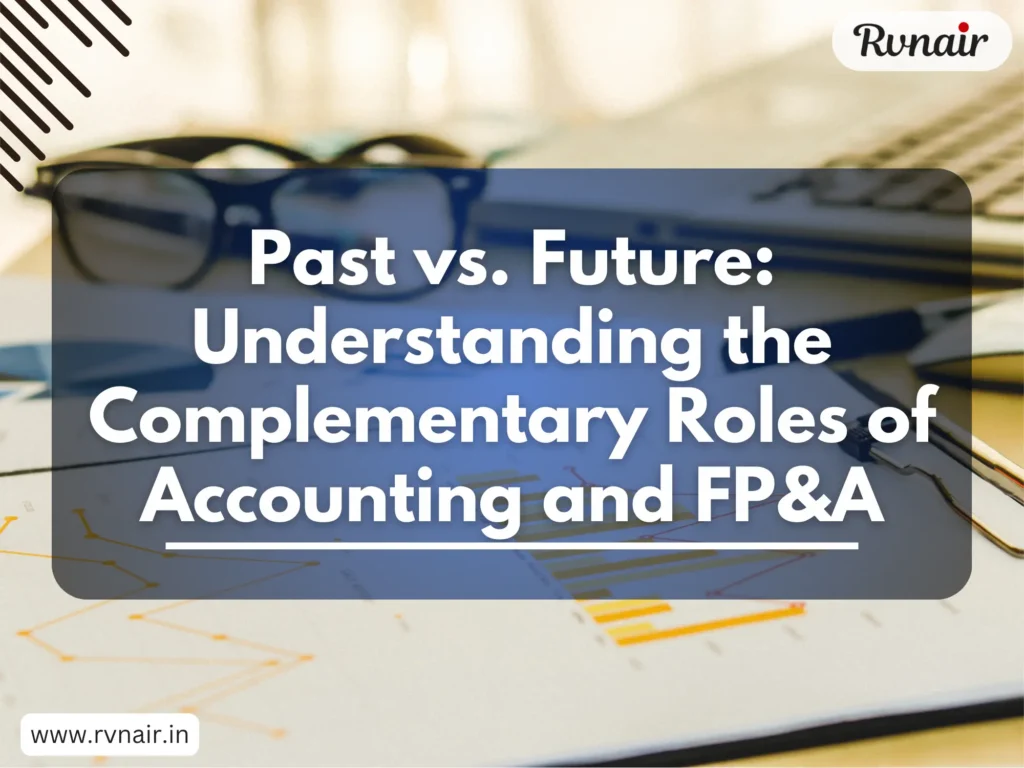
In the world of corporate finance, two functions often stand side by side yet serve distinctly different purposes: Financial Planning & Analysis (FP&A) and Accounting. While both are essential to an organization’s financial health, they approach financial management from different angles and with different objectives. This blog explores the key differences between these two critical finance functions, from their core responsibilities to career trajectories.
Understanding FP&A and Accounting
Definition of FP&A
Financial Planning & Analysis (FP&A) is a forward-looking function focused on financial forecasting, budgeting, and performance analysis. FP&A professionals translate financial data into actionable business insights, helping leadership make informed strategic decisions about the company’s future. They serve as the financial navigators of an organization, charting the course toward financial targets and identifying potential opportunities and risks along the way.
Definition of Accounting
Accounting is the systematic recording, reporting, and analysis of financial transactions. It creates a historical record of a company’s financial activities, ensuring compliance with regulatory standards and providing accurate financial statements. Accounting serves as the financial foundation of an organization, documenting what has occurred and maintaining the integrity of financial information.
Core responsibilities of FP&A professionals
- Developing and managing budgets and forecasts
- Creating financial models to analyze potential business scenarios
- Providing variance analysis to explain differences between actual and planned results
- Supporting strategic decision-making with financial insights
- Identifying trends and opportunities for financial improvement
- Collaborating with department leaders to develop financial plans
Core responsibilities of accountants
- Recording and processing financial transactions
- Preparing financial statements (income statements, balance sheets, cash flow statements)
- Ensuring compliance with financial regulations and tax requirements
- Managing accounts payable and receivable
- Conducting audits to verify financial accuracy
- Maintaining the general ledger and financial records
Key Differences in Focus
FP&A’s forward-looking approach
FP&A professionals are primarily concerned with what will happen in the future. They use historical data as a foundation but focus on forecasting, projecting, and planning for upcoming quarters and years. Their work involves scenario planning, sensitivity analyses, and building models that predict future financial outcomes based on different variables and assumptions.
Accounting’s historical perspective
Accounting, by contrast, is predominantly backward-looking. Accountants meticulously document what has already occurred, creating an accurate and complete record of past financial transactions. Their work ensures that historical financial data is accurate, organized, and properly reported, providing a reliable picture of the company’s financial history.
Strategic vs. transactional orientation
FP&A takes a strategic orientation, connecting financial data to broader business objectives and market conditions. FP&A professionals ask questions like: “How should we allocate resources to maximize growth?” and “What financial strategies will best support our business goals?”
Accounting is more transactional in nature, focusing on the accurate processing and recording of individual financial events. While this work supports strategic decisions, accounting itself is concerned with precision, compliance, and thoroughness in financial reporting rather than strategic planning.
Decision support vs. financial reporting
FP&A exists primarily to support decision-making. The analyses, forecasts, and recommendations provided by FP&A professionals help executives and managers make choices about investments, resource allocation, pricing strategies, and other business decisions with significant financial implications.
Accounting’s primary purpose is financial reporting—creating standardized documents that accurately reflect the company’s financial position for stakeholders including investors, regulators, and management. While these reports inform decisions, their creation is governed by established accounting principles rather than business strategy needs.
Skill Sets and Expertise
Essential FP&A skills
- Advanced financial modeling and forecasting
- Business acumen and strategic thinking
- Data analysis and interpretation
- Scenario planning and sensitivity analysis
- Communication and presentation skills
- Cross-functional collaboration abilities
Critical accounting competencies
- Knowledge of accounting principles and standards (GAAP, IFRS)
- Attention to detail and accuracy
- Understanding of tax laws and regulations
- Audit preparation and compliance expertise
- Process documentation and control
- Financial statement preparation
Overlapping abilities
Both FP&A and accounting professionals need:
- Strong quantitative abilities
- Excel proficiency
- Financial statement literacy
- Understanding of business operations
- Ethical standards and integrity
- Time management and organizational skills
Unique specializations in each field
FP&A specializations often include:
- Long-range financial planning
- Capital expenditure analysis
- Business partnering with operational units
- Investor relations support
Accounting specializations commonly include:
- Tax accounting
- Audit and assurance
- Financial accounting
- Cost accounting
- Regulatory compliance
Tools and Technologies
FP&A software and platforms
FP&A professionals typically use:
- Advanced planning systems (Anaplan, Adaptive Insights, Planful)
- Business intelligence tools (Power BI, Tableau, Looker)
- Scenario planning software
- Rolling forecast applications
- Integrated financial planning platforms
Accounting systems and tools
Accountants generally rely on:
- Enterprise Resource Planning (ERP) systems (SAP, Oracle, NetSuite)
- Specialized accounting software (QuickBooks, Xero, Sage)
- Tax preparation programs
- Audit management systems
- Compliance monitoring tools
Data analysis capabilities
FP&A leverages:
- Predictive analytics
- Trend analysis
- Correlation studies
- Driver-based modeling
- What-if scenario building
Accounting focuses on:
- Variance analysis
- Reconciliation tools
- Exception reporting
- Audit sampling
- Historical transaction analysis
Reporting and visualization differences
FP&A reporting emphasizes:
- Interactive dashboards
- Dynamic visualizations
- Flexible reporting frameworks
- KPI-focused displays
- Customized executive presentations
Accounting reporting prioritizes:
- Standardized financial statements
- Regulatory compliance documents
- Audit trails and documentation
- Structured, consistent formats
- Period-over-period comparisons
Career Paths and Opportunities
FP&A career progression
A typical FP&A career path might look like:
- Financial Analyst
- Senior Financial Analyst
- FP&A Manager
- Director of FP&A
- VP of Financial Planning
- CFO
Accounting career trajectory
Common accounting career paths include:
- Staff Accountant
- Senior Accountant
- Accounting Manager
- Controller
- Director of Accounting
- CFO
Salary comparisons
Generally, FP&A roles command slightly higher salaries than accounting positions at equivalent levels, particularly at mid and senior levels. This salary premium reflects the strategic nature of FP&A work and its direct impact on business decision-making. However, specialized accounting roles (such as tax directors or audit partners) can be very well compensated.
Industry demand for each role
Both FP&A and accounting professionals remain in high demand, though for different reasons:
- FP&A demand grows with increased emphasis on data-driven decision making and strategic planning
- Accounting demand remains stable due to regulatory requirements and the essential nature of financial reporting
Potential for cross-functional moves
Movement between the fields is possible and often beneficial:
- Accountants moving to FP&A gain strategic perspective and business partnering skills
- FP&A professionals moving to accounting strengthen their technical foundation and compliance knowledge
- Both transitions typically require additional training or education
- The CFO role often requires experience in both areas
Collaboration and Synergies
How FP&A and Accounting work together
Effective organizations integrate these functions through:
- Regular information sharing meetings
- Collaborative planning processes
- Shared technology platforms
- Combined financial reviews
- Joint improvement initiatives for financial processes
Shared goals and objectives
Despite their differences, both functions aim to:
- Ensure financial health of the organization
- Provide accurate financial information
- Support sustainable business growth
- Manage financial risks effectively
- Optimize resource allocation
Communication between departments
Successful finance teams establish:
- Clear data handoff protocols
- Regular cross-functional meetings
- Shared terminology and definitions
- Transparent timelines and expectations
- Collaborative problem-solving approaches
Enhancing organizational financial performance
When working in harmony, FP&A and accounting create a powerful synergy that:
- Provides both historical accuracy and future insight
- Balances compliance requirements with strategic needs
- Combines detailed transaction management with big-picture thinking
- Creates a complete financial management ecosystem
- Delivers more value than either function could provide independently
While FP&A and accounting may approach financial management from different angles, successful organizations recognize that both perspectives are essential. The historical precision of accounting provides the foundation upon which the forward-looking analyses of FP&A can build, creating a comprehensive financial framework that supports both operational excellence and strategic growth.
